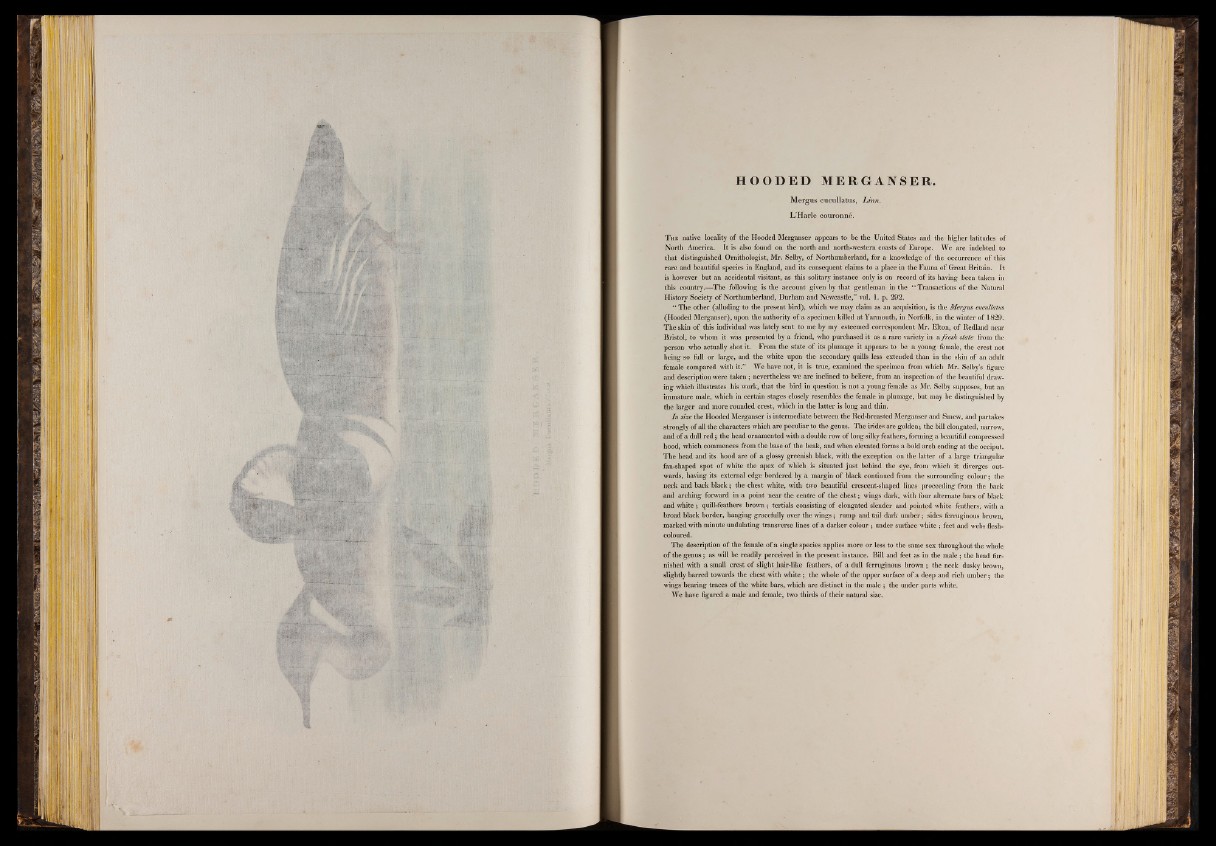
H R
IS.
| |R
Kl i
■
i n
I v i i i
I ....
È&Æiî
1 1 1 1
I
H HW p P p B . K
m iÊ ÈËBMÊSmËÊfflS gtMR I ^ Æ!
■ . s / m m
M 11
1
rtSIRpSiil
’Ê t e sw
II
H O O D E D ME R GA N S E R .
Mergus cucullatus, L in n .
L’Harle couronné.
T he native locality of the Hooded Merganser appears to be the United States and the higher latitudes of
North America. It is also found on the north and north-western coasts o f Europe. We are indebted to
that distinguished Ornithologist, Mr. Selby, of Northumberland, for a knowledge of the occurrence of this
rare and beautiful species in England, and its consequent claims to a place in the Fauna of Great Britain. It
is however but an accidental visitant, as this solitary instance only is on record of its having been taken in
this country.—The following is the account given by that gentleman in the “ Transactions of the Natural
History Society o f Northumberland, Durham and Newcastle,” vol. 1. p. 292.
“ The other (alluding to the present bird), which we may claim as an acquisition, is the Mergus cucullatus
(Hooded Merganser), upon the authority of a specimen killed at Yarmouth, in Norfolk, in the winter of 1829.
The skin of this individual was lately sent to me by my esteemed correspondent Mr. Elton, of Redland near
Bristol, to whom it was presented by a friend, who purchased it as a rare variety in a fresh state from the
person who actually shot it. From the state o f its plumage it appears to be a young female, the crest not
being so full or large, and the white upon the secondary quills less extended than in the skin of an adult
female compared with it.” We have not, it is true, examined the specimen from which Mr. Selby’s figure
and description were taken ; nevertheless we are inclined to believe, from an inspection of the beautiful drawing
which illustrates his work, that the bird in question is not a young female as Mr. Selby supposes, but an
immature male, which in certain stages closely resembles the female in plumage, but may be distinguished by
the larger and more rounded crest, which in the latter is long and thin.
In size the Hooded Merganser is intermediate between the Red-breasted Merganser and Smew, and partakes
strongly o f all the characters which are peculiar to the genus. The irides are golden; the bill elongated, narrow,
and o f a dull red ; the head ornamented with a double row o f long silky feathers, forming a beautiful compressed
hood, which commences from the base o f the beak, and when elevated forms a bold arch ending at the occiput.
The head and its hood are of a glossy greenish black, with the exception on the latter of a large triangular
fan-shaped spot of white the apex o f which is situated just behind the eye, from which it diverges outwards,
having its external edge bordered by a margin of black continued from the surrounding colour ; the
neck and back black ; the chest white, with two beautiful crescent-shaped lines proceeding from the back
and arching forward in a point "near the centre o f the chest ; wings dark, with four alternate bars of black
and white ; quill-feathers brown ; tertials consisting o f elongated slender and pointed white feathers, with a
broad black border, hanging gracefully over the wings ; rump and tail dark umber ; sides ferruginous brown,
marked with minute undulating transverse lines of a darker colour ; under surface white ; feet and webs flesh-
coloured.
The description of the female of a single species applies more or less to the same sex throughout the whole
of the genus ; as will be readily perceived in the present instance. Bill and feet as in the male ; the head furnished
with a small crest o f slight Jiair-like feathers, of a dull ferruginous brown ; the neck dusky brown,
slightly barred towards the chest with white ; the whole of the upper surface of a deep and rich umber ; the
wings bearing traces of the white bars, which are distinct in the male ; the under parts white.
We have figured a male and female, two thirds of their natural size.